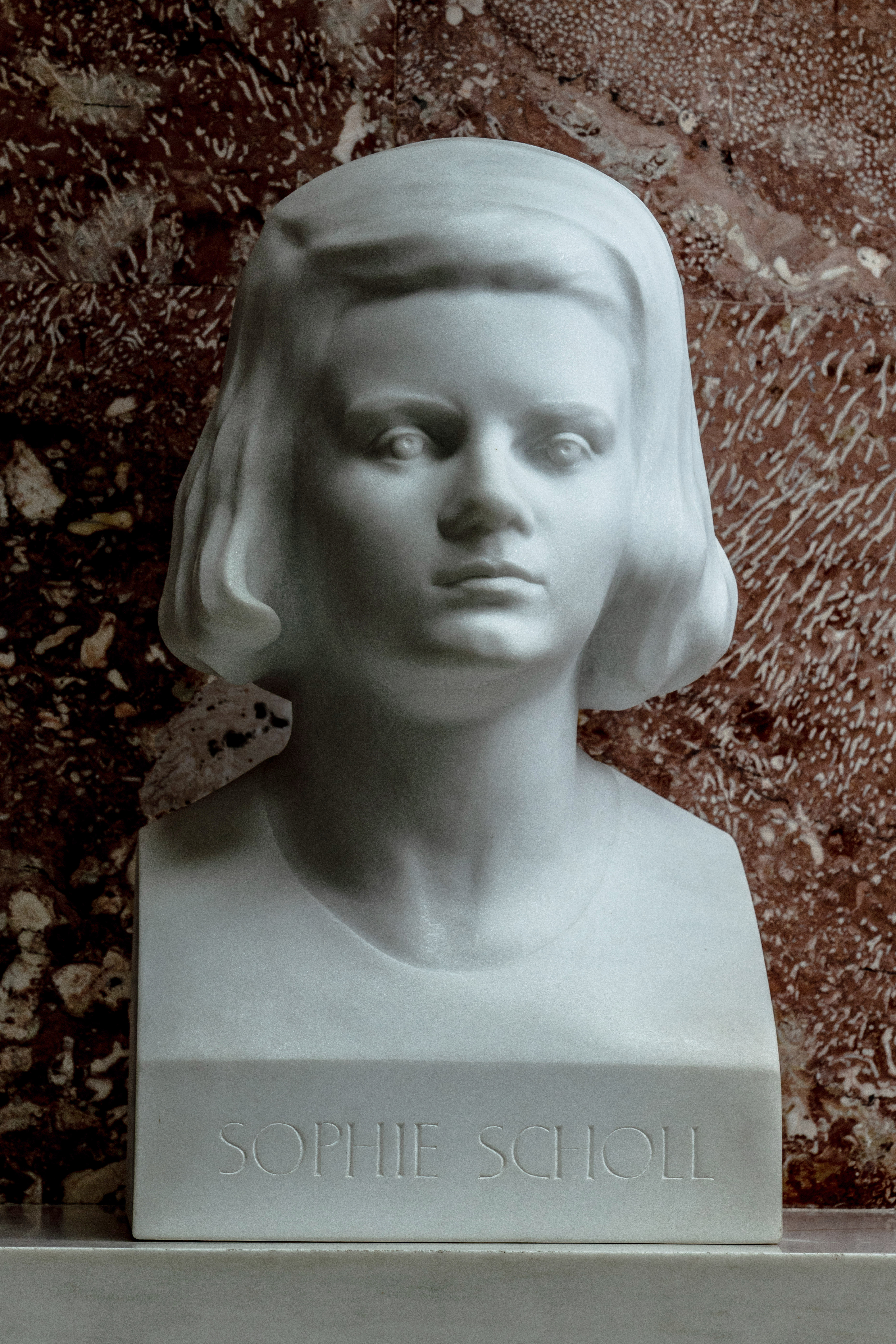Read Dr Alex Lloyd’s essay on Sophie Scholl from the 2020 White Rose Project Digital Symposium.
At times, Sophie Scholl’s involvement and significance within the White Rose resistance has been marginalized (along with that of other women); yet at others she has been transformed into an icon, co-opted and invested with meaning in ways that silence her own unique voice. To what extent can we speak of Sophie Scholl as an icon, and how can this help us to understand and tell stories about individuals who resist? The central figures in the White Rose resistance are well known in Germany: Sophie Scholl, Hans Scholl, Christoph Probst, Alexander Schmorell, Willi Graf, and Kurt Huber. In the English-language reception of the group, though, much of the literature and imagery focuses on Sophie Scholl. In a way, this is hardly surprising: she is much more likely to be familiar to UK audiences given the success of Marc Rothemund’s Oscar-nominated film Sophie Scholl: The Final Days (2005), which tells the story of the Scholls’ arrest and the first White Rose trial from Sophie’s perspective. She is also much less potentially problematic than, say, the male students in the core group, all of whom were conscripted into the army as medics, and who were therefore part of the war machine they were trying to undermine. In different ways, Sophie provides an accessible figurehead for the movement.
‘Icon’ seems an appropriate term to use when talking about Sophie Scholl’s place in post-war memory culture. It suggests a level of celebrity which, for reasons associated with the reception of the White Rose in West Germany, she has undoubtedly reached. In 2003, for example, the German broadcaster ZDF ran a programme called Our Best (Unsere Besten), which, like the BBC’s 100 Greatest Britons, asked viewers to decide ‘Who are the best Germans’. Sophie and Hans Scholl were voted joint fourth, behind Konrad Adenauer, Martin Luther, and Karl Marx. Sophie was the only woman in the top ten.
‘Icon’ is also a term associated with Christian practices of commemoration. Sophie’s letters and diaries contain a religious fervour and critical self-examination at times reminiscent of saintly writings. In a diary entry from 29 June 1942, for example, she writes:
My God, I can do nothing but cry out to you falteringly. I can do nothing but hold out my heart to you that is drawn away from you by a thousand desires […] Teach me to pray. Better to bear an unbearable pain than to go on living insensately. Better a burning thirst, better to pray for pain, pain, pain than for an emptiness to be filled, an emptiness and to feel it without really feeling anything. I mean to resist it.
The influence of Christianity on the group, and its members’ varying degree of personal faith, are a significant part of the story. Faith shaped their lives, their deaths, and has shaped their legacy. Alexander Schmorell was canonized as a Holy Martyr in the Russian Orthodox Church in 2012 and discussions are ongoing in the Roman Catholic Church to open a cause for the beatification of Willi Graf. Like so much of the White Rose story, however, their faith is easily reduced, overplayed or underplayed, to suit the needs of writers rather than reflect the messier reality of their subjects’ lives.
This Christian iconography is central to Rothemund’s film Sophie Scholl: The Final Days and critics have rightly identified links with Carl Theodor Dreyer’s landmark silent film The Passion of Joan of Arc (1928). I agree with scholars like Axel Bangert and Anne Fuchs who argue persuasively that the film provides an intimate encounter with Sophie and a focus on the psychology of resistance. Yet it is striking that in telling the story of one ‘iconic’ woman, a visual connection is made with another, and with another female icon. We find something similar in the Berlin branch of Madame Tussauds, where a waxwork of Sophie Scholl stands in the same room as one of Anne Frank who is sitting at a desk, pen in hand, diary open in front of her. In a strange sense, Sophie Scholl and Anne Frank appear here as parallel icons in popular culture: censored of the complex reality of their lives, silent icons of a dark chapter in history.
In West Germany, Anne Frank undoubtedly provided the most public symbol of Jewish suffering in the Holocaust. Her diary was first published in Germany in 1949 with a limited print run, and even when it was taken up by the publishing house Fischer in 1955, it was not initially a best-seller. It only came to prominence with Das Tagebuch der Anne Frank, the German translation of the American stage play The Diary of Anne Frank, by Frances Goodrich and Albert Hackett, which was first performed in Germany on 1 October 1956. It was, then, not actually Anne Frank’s own voice that initially captured the imaginations and hearts of the German public, but rather the adaptation of that voice by other writers. The German philosopher Theodor W. Adorno commented on a story he heard from a friend attending a performance of Goodrich and Hackett’s stage play:
I once heard the story of a woman who, after attending a performance of the dramatisation of The Diary of Anne Frank, said in a shaken voice: ‘Yes, but really, at least that girl ought to have been allowed to live.’
The literary construction of Anne Frank becomes a sentimental figure and one with whom an audience or reader can empathize without having to engage with the totality of the Holocaust, perhaps even, in Adorno’s example, without having to deprecate it. For Adorno, Anne Frank becomes an ‘alibi for the whole’.
Sophie Scholl has also been immortalised in the Walhalla memorial, an imposing neo-classical building set high above the Danube river, filled with plaques, busts, and statues of ‘noted Germans’. Here, Sophie is enshrined among the great and the good of German history, along with a plaque dedicated to all those who resisted fascism.

On the one hand, it is right to welcome an emphasis on Sophie’s contribution. It serves as a corrective to the marginalisation of women in history. Moreover, this was Nazi Germany, where a woman’s role was conservatively defined, and serial motherhood rewarded. Indeed, only a few days before Sophie’s arrest, the Gauleiter (regional governor) of Bavaria had given a speech to mark the 470th anniversary of the foundation of the University, in which he upbraided female students for studying rather than fulfilling their duties as wives and mothers, and later offered to find husbands for any women who were ‘not pretty enough’ to do so by themselves. A protest ensued, but it was short-lived.
On the other hand, it is important to distinguish between the depiction of Sophie as passive icon, on the one hand, and on the other, as an historical agent who joined together with others to stake a stand against the regime. Examining the legacy of Sophie’s role in the group forms part of a broader, more pressing question: how do we talk about those who resisted? How do we do justice to the complexity of their lives and actions? Miriam Gebhardt puts this well in her recent study of the psychology of those who resisted (p. 259):
They were no superheroes […]. But neither were they wraithlike martyrs who, strengthened by their faith, went light of foot to the gallows. They were normal young people, who sometimes overestimated themselves, who took risks, but who were always aware of the danger within the National Socialist state.
In a world increasingly dominated by social media, though, such nuances are easily lost. It is short-hands, icons, that count. Images of Sophie can be put to the use of all sorts of agendas. Indeed, in January 2017 it was reported that the Nuremberg-South region of the Alternative für Deutschland (Alternative for Germany) party had used an image of Sophie Scholl to advertise on Facebook. She appears alongside a quotation from the first White Rose pamphlet and the slogan ‘Sophie Scholl would have voted for the AfD’.
Icons can help us, by providing identifiable figures who provoke empathy and reflection. This is undeniably of use when we attempt to negotiate and make legible this chapter of history. Still, it also risks reducing individuals, denying their complexities and their voices. Part of the work of the White Rose Project in Oxford is to do these individuals justice as best we can, and to make space for their voices to be heard.
References
Hans Scholl and Sophie Scholl, Hans Scholl, Sophie Scholl: Briefe und Aufzeichnungen, ed. by Inge Jens (Frankfurt a.M.: Fischer Taschenbuch Verlag, 1988), my translation
Theodor W. Adorno, ‘What Does Coming to Terms with the Past Mean?’, in Bitburg in Moral and Political Perspective, ed. by Geoffrey H. Hartman (Bloomington: Indiana University Press, 1986), pp. 114–29 (p. 127).
Miriam Gebhardt, Die Weiße Rose: Wie aus ganz normalen Deutschen Widerstandskämpfer wurden (Munich: dtv, 2017)

Alexandra Lloyd is a Fellow by Special Election in German Studies at St Edmund Hall, and Lecturer in German at Magdalen College and Trinity College, Oxford. She also leads the White Rose Project.
